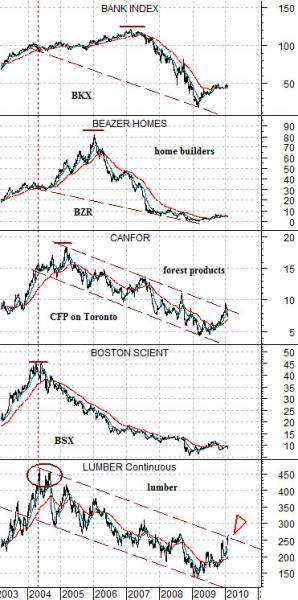We mentioned a week or two ago that Goldman Sachs had argued that the Fed was unlikely to raise the funds rate until some time towards the middle of 2011. Last month RBC Capital Markets suggested that based on a modified Taylor Rule- using the Fed’s forecasts for inflation and GDP growth- a rate increase was unlikely through 2011. In other words the output gap as a percentage of potential GDP is sufficiently large enough to keep over night interest rates close to 0% for some time to come.
We argued back in early 2004 that energy price strength would force the Fed to push short-term interest rates higher. The chart below shows that heating oil futures broke to new all time highs towards the middle of 2004. This initiated a domino-like effect through the markets that we will discuss on the following page.
One of our recent arguments has revolved around what has happened in the past in between the peak for Japanese long-term bond prices and the start of monetary tightening by the Federal Reserve. The idea was that the Japanese equity market tends to do nicely once the JGB 10-year bond futures peak and turn lower through to the first Fed rate hike.
The chart at right shows that the JGBs topped out in mid-2003 only to bottom just ahead of the break out by heating oil futures in mid-2004 that went with the first increase in the funds rate following the post-Nasdaq bubble recession.


Equity/Bond Markets
We were attempting to lay out a few parameters on page 1 today. Short-term interest rates began to plummet towards the end of 2000 with the long end of the Japanese bond market pushing on to a price peak in mid-2003. The ‘window’ for outperformance by the Nikkei extended from the summer of 2003 through into the middle of 2004.
As mentioned the markets changed themes rather dramatically back in 2004 as energy prices moved to new highs. In other words while economist might worry about ‘the output gap’ the real issue is actually ‘what output gap’.
Our point is that the tightest market in terms of demand and supply will always recover the fastest. While the Goldman Sachs’ argument was that the Fed will not begin to tighten credit until some time after the U.S. employment rate begins to decline it is highly unlikely that U.S. employment is going to be the ‘tightest market’.
Our concern as we watched crude oil futures prices climb from 30 to 40 to 50 and eventually through 80 was that ‘energy’ was once again going to be the choking point. In a perfect world crude oil prices hunker down near current levels and hold below the highs set in 2008 for a decade or two.
At right is a chart comparison that we have shown in these pages on a number of occasions over the past few years. The chart is anchored at the bottom by lumber futures. From there we work through the share price of Boston Scientific (BSX), Canadian forest products company Canfor (CFP on Toronto), U.S. home builder Beazer (BZR), and the Bank Index (BKX).
When the Nasdaq began to crumble in late 2000 downward pressure was applied to interest rates. One of the offsets to collapsing capital spending was an improvement in consumer spending and the way the markets helped create this was initially through falling mortgage rates and eventually through rising U.S. home prices.
One of the first markets to react to falling yields in 2000 was lumber futures but once heating oil futures pushed to new highs in 2004 lumber prices peaked and turned lower. Stocks like BSX which had been trending with lumber prices turned lower and eventually the forest products sector followed to the down side.
With lumber prices and the forestry stocks in negative trends the stage was set for a cycle peak in the home builders. Beazer reached its top around the end of 2005.
The banks were, of course, neck-deep in mortgage-related activity so with the benefit of hind sight it should come as no surprise that a year after the home builders began to decline the share prices of the major banks reached a top.
Our view- or hope, perhaps- is that the cycle is starting once again as lumber prices trend higher. A window exists between ‘now’ and the point in time when one or more markets become so strong that the Fed is forced to tighten credit once again. If Goldman Sachs and RBC are correct then the window should remain open through all of this year and perhaps through much of 2011.




